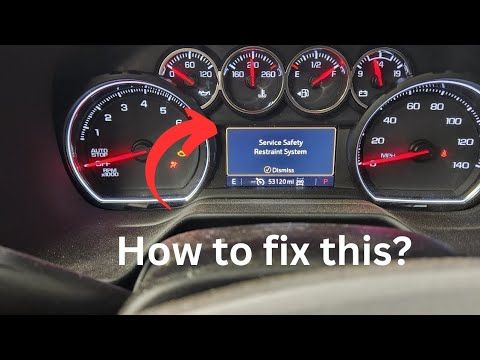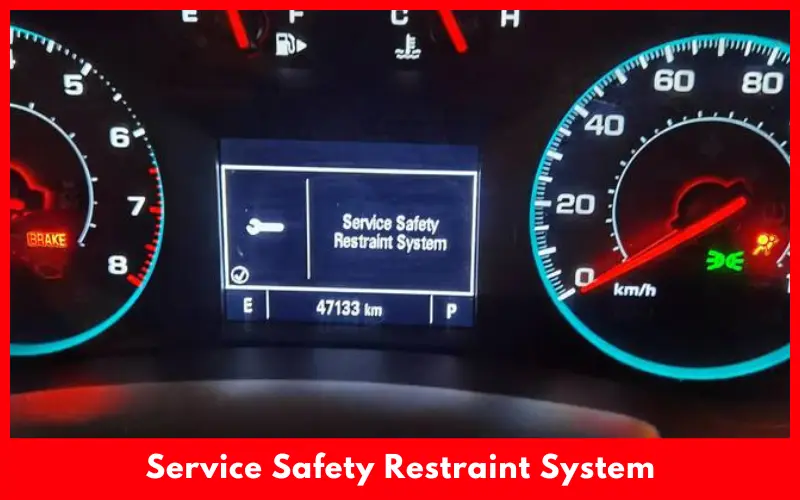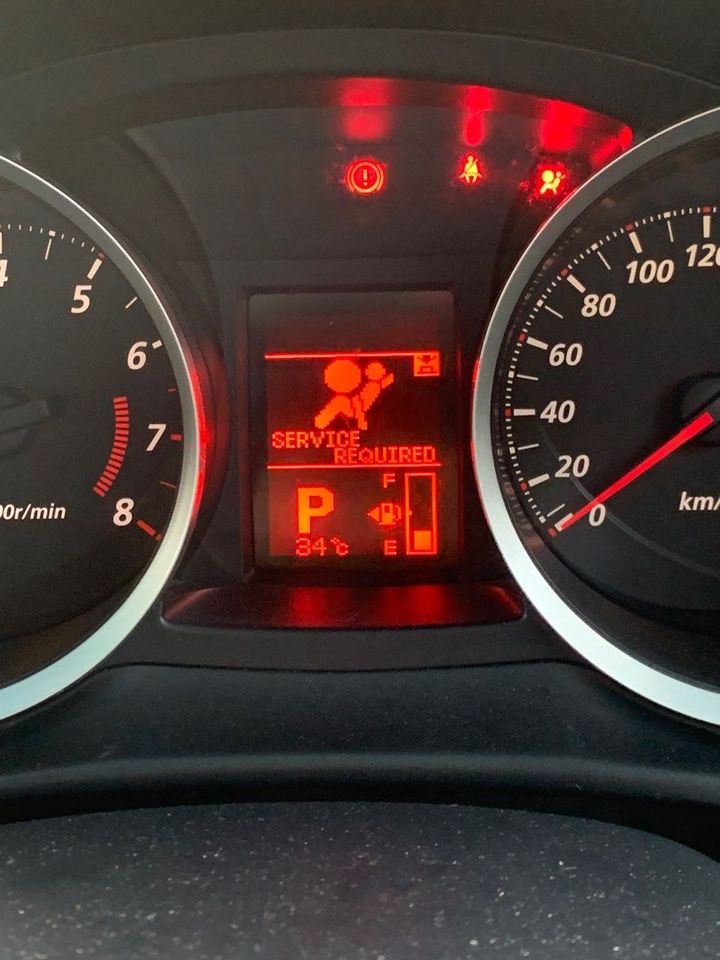


Ensuring the proper functioning of your vehicle's service safety restraint system is crucial for protecting you and your passengers in the event of a collision. This comprehensive guide will provide you with an in-depth understanding of this critical system, the common causes of warning light illumination, and the steps to reset it when necessary. We'll also explore troubleshooting techniques, maintenance best practices, and when to seek professional assistance.

The service safety restraint system is a vital component in modern vehicles, designed to mitigate the impact of collisions and protect occupants from serious injury. This sophisticated system comprises several interconnected elements, each playing a crucial role in its overall operation.
| Component | Function |
|---|---|
| Airbags | Inflatable cushions that rapidly deploy during a collision, providing a protective barrier between the occupant and the vehicle's interior surfaces. |
| Seatbelt Pre-tensioners | Work in conjunction with airbags to tighten seatbelts and secure occupants in their seats, preventing them from being thrown forward or ejected. |
| Sensors | Monitor the vehicle's movements and detect sudden deceleration or impact, triggering the deployment of airbags and activation of pre-tensioners. |
| Electronic Control Module (ECM) | Acts as the brain of the system, continuously evaluating sensor data and coordinating the appropriate response. |
When functioning correctly, the service safety restraint system can significantly reduce the risk of injury or fatality in the event of a collision. However, if any component malfunctions or becomes compromised, the system's effectiveness may be compromised, putting occupants at risk.
The service safety restraint system is designed to alert the driver when there is a potential issue by illuminating a warning light on the dashboard. Several factors can trigger this warning light, and it's essential to address the underlying cause promptly to ensure the system's proper functioning.
Faulty seatbelt buckles or retractors
Airbag sensor issues
Loose wiring or electrical connections
Recent accident with airbag deployment
Battery disconnection or low voltage
If the service safety restraint system warning light is illuminated, resetting the system may resolve the issue, especially if it was triggered by a minor fault or after a battery disconnection. However, it's essential to consult your vehicle's owner's manual for specific instructions, as the reset procedure can vary between manufacturers and models.
Before attempting a reset, ensure you have gathered any necessary tools, such as a diagnostic scan tool or a specific key sequence, as outlined in the owner's manual. Once you're prepared, follow these general steps:
Insert the key and turn the ignition to the "On" position, but do not start the engine.
Observe the warning light; it should illuminate and then turn off after a few seconds, indicating that the system is running a self-check.
Turn the ignition off and wait a few seconds.
Repeat steps 1-3 two or three times.
Start the engine and verify that the warning light is no longer illuminated.
If the warning light remains on after completing the reset procedure, it may indicate a more serious issue that requires further troubleshooting or professional assistance.
If the service safety restraint system warning light persists after attempting a reset, there are several troubleshooting steps you can take to identify and address the underlying issue.
| Troubleshooting Step | Description |
|---|---|
| Inspect Wiring and Connectors | Look for any loose or damaged wiring or connectors around the airbag modules, seatbelts, and under the seats/dashboard. Securely reconnect or repair as needed. |
| Check Seatbelts | Carefully inspect the seatbelts for any signs of damage, stuck latches, or obstructions preventing them from retracting fully. |
| Scan for Diagnostic Trouble Codes | Use an OBD2 scanner tool to scan for diagnostic trouble codes, which can provide insights into the specific issue causing the warning light to remain on. |
However, if these troubleshooting steps fail to resolve the issue, it's recommended to seek professional assistance from a qualified mechanic or dealership. They have access to specialized diagnostic equipment and expertise to accurately diagnose and repair any underlying issues with the service safety restraint system.
Proper maintenance and handling of the service safety restraint system are essential to ensure its optimal performance and longevity. By following these best practices, you can help prevent issues and minimize the risk of warning light illumination.

Wear seatbelts properly and avoid any modifications or tampering that could interfere with their operation.
Handle airbag components with care during any repairs or maintenance.
Keep the area around sensors and wiring clear of debris, moisture, or other contaminants.
Include the service safety restraint system in your regular vehicle maintenance schedule.
While some issues with the service safety restraint system can be addressed through resetting and basic troubleshooting, there may be instances where professional diagnosis and repair are necessary. Ignoring serious issues or attempting complex repairs without the proper expertise can compromise the system's effectiveness and put occupant safety at risk.
If the warning light persists after troubleshooting or if you suspect a more significant issue, it's crucial to seek assistance from a qualified professional. They have access to specialized diagnostic tools and equipment that can accurately pinpoint the root cause of the problem, whether it's a faulty component, wiring issue, or software glitch.
| Repair Process | Description |
|---|---|
| Diagnosis | Professionals use specialized diagnostic tools and equipment to accurately pinpoint the root cause of the problem. |
| Parts Replacement | Depending on the diagnosis, repairs may involve replacing defective parts, such as sensors, airbag modules, or the electronic control module itself. |
| Genuine Parts | It's essential to use genuine, manufacturer-approved replacement parts to ensure compatibility and proper functioning. |
| Reputable Repair Facility | Choose a reputable and experienced service center or dealership with trained technicians familiar with the service safety restraint system. |
While professional repairs may come at a higher cost, investing in the proper diagnosis and repair of the service safety restraint system is a worthwhile investment in the safety of you and your passengers.
The service safety restraint system is a critical component in modern vehicles, designed to protect occupants in the event of a collision. By understanding its components, recognizing warning signs, and following proper maintenance and repair procedures, you can ensure your safety on the road. Don't ignore that pesky warning light – take action today to reset the system or seek professional assistance if needed. Your safety and the safety of your passengers should always be the top priority.
The warning light indicates a potential issue with the airbags, seatbelts, or other components of the safety restraint system. It alerts the driver that the system may not function properly in a collision.
No, you should never ignore the warning light as it could indicate a serious problem that compromises the effectiveness of the safety system in protecting you during a crash.
It's recommended to have the system inspected as part of your regular vehicle maintenance schedule, typically once a year or according to the manufacturer's guidelines.
If the warning light illuminates while driving, you should have the vehicle inspected by a professional as soon as possible, but it is generally safe to continue driving cautiously until you can get it serviced.
Yes, a dead or disconnected battery can sometimes trigger the warning light, as the system may lose its stored data or settings. Resetting the system after replacing the battery may resolve the issue.
It is generally not safe to drive with a known issue in the safety restraint system, as it may not provide adequate protection in the event of a collision. Seek professional repair as soon as possible.
Some minor issues can be resolved by resetting the system yourself, following the instructions in the owner's manual. However, for persistent or more complex issues, professional diagnosis and repair are recommended.
If the airbags deploy in an accident, they will need to be replaced, as they are designed for single-use only. The entire system will also need to be inspected and potentially reset or repaired.
It is strongly recommended to use genuine, manufacturer-approved replacement parts when repairing the safety restraint system to ensure proper functionality and compatibility.
Proper maintenance, avoiding modifications or tampering with the system components, and handling airbag components with care during repairs can help prevent issues with the service safety restraint system.

Sarah isn't your average gearhead. With a double major in Mechanical Engineering and Automotive Technology, she dived straight into the world of car repair. After 15 years of turning wrenches at dealerships and independent shops, Sarah joined MICDOT to share her expertise and passion for making cars run like new. Her in-depth knowledge and knack for explaining complex issues in simple terms make her a valuable asset to our team.













